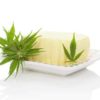If you already know how to roll a joint, figuring out how to roll a tulip joint is easier than you would think. With that said, a tulip joint is not for beginner rollers or rookie smokers. In fact, the amount of smoke you get gradually increases as you burn through the tulip joint. So you better get your lungs ready.
Starting from the tip of the J, it goes from small to large then back to small, which means you’ll get a little bit of smoke, then a ton of smoke, then it’ll finish off by giving your lungs a bit of a break. This guide will walk you through the entire process, so you’ll know how to roll a tulip joint.
Why Roll a Tulip Joint?

Bitnote
There are several reasons to roll a tulip joint. Maybe you’re rolling it as a gift. There are plenty of people who would take a tulip joint over flowers on Valentine’s Day. Are you just getting into rolling more artistic joints? The tulip joint is a great place to start. Your friends will be thoroughly entertained and happy to smoke it with you.
Beyond aesthetics, are there any practical benefits to rolling a joint in the shape of a tulip? The only one we can think of is that it makes it easy to fit large amounts of bud into a single joint. It’s also just a fun way to switch things up with your circle of friends that smoke cannabis.
The way it smokes is by starting small, getting bigger, then going back to a normal-sized joint. It’s like going for a jog, increasing speed until you’re in an all-out sprint, then finishing off the workout with a light jog.
How To Roll a Tulip Joint
The basic idea behind a tulip joint is to combine a thin pinner joint and a fat cone joint so that it looks like a tulip. The pinner joint becomes the “stem” of the tulip, and the cone becomes the “flower” portion of the tulip. To roll a tulip joint, this is what you’re going to need:
Step 1: Roll a Pinner Joint

You want your weed finely-ground before you begin the rolling process. Similarly, be sure to choose the right rolling papers. Then, get your tulip joint started by rolling a regular pinner joint. Remember to roll this one thin and tight, since it will be the stem of your tulip joint.
Step 2: Make a Cone Joint

Reddit
Next, you’re going to roll a cone joint. To really accentuate the tulip shape you’re going for, roll a cone that’s fat and stocky rather than long and thin. Brab two large pieces of paper and stick them together by licking one of the gummed strips.
Now fold the combined pieces of paper into a cone shape. Lick the other gummed strip and seal the other side shut to complete the cone. Next, open up the top of the cone, and you’re ready to start filling it. Pack in as much weed as you want.
Step 3: Combine Them to Make Your Tulip Joint

Reddit
Now that you’ve got your pinner joint and your cone joint, it’s time to combine them to form a tulip. Finish off your cone joint, but leave enough of an opening in the fat end of the cone to insert the pinner joint.
Now, rip off the gummed strip from the last piece of paper and use it to fasten the pinner joint to the giant cone of weed. At this point, if you followed all of the above steps you should have a ready-to-smoke tulip joint. Share it with friends or give it as a gift to someone who loves weed.
Final Hit: How To Roll A Tulip Joint
Tulip joints are a good stepping stone for you to become a master joint roller. After you master this design, you can move on to other sick joints like a cross joint or a braided joint.
As far as the tulip joint goes, if you can roll a good cone joint and a good pinner joint, you have all the skills you need. It’s really just a matter of linking them both together. The finished product looks like a tulip: The thin pinner joint is the stem, and the fat cone is the flower.























